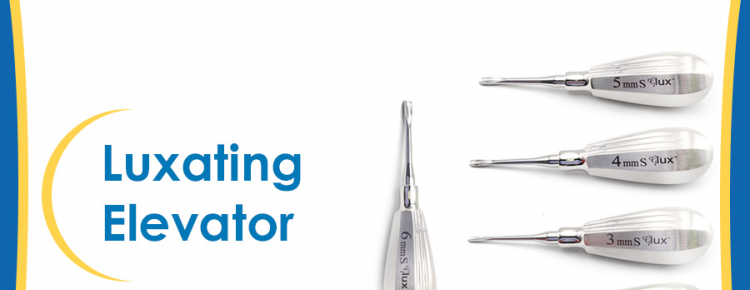
Table of Contents
- Luxating Elevators
- Dental Elevators?
- Basic Usage of Luxating Elevators and Standard Elevators
- Difference Between a Luxating Elevator and a Standard Elevator?
- What do Dentists Prefer to Use for Dental Treatment?
- Things to Consider While Selecting the Elevators:
- How to Choose the Best Elevator for Your Practice?
Dentists use various innovative dental surgical tools for efficient tooth extraction procedures. Removing a tooth is an extremely complex and painful procedure that requires tools with minor variations for accuracy. Dentists prefer to use luxating elevators to avoid any inconvenience while performing the extraction.
Whereas there are many types of elevators that assist dentists in luxating roots before applying forceps. But luxating elevators are thinner and sharper instruments in comparison to traditional dental elevators. In addition, the instrument provides a clean cut to ensure quick post-operative healing.
However, both elevators are almost similar, but some of the functions make their preferences different in dental procedures.
Let’s learn more about the basic difference between dental elevators and dental luxating elevators and see which one is more advantageous to use for dental practices.
Luxating Elevators
Luxating elevators are ideal dental tools with a thinner blade that help to luxate the tooth before extraction. It consists of a thick and small handle that perfectly fits in the dentist’s hand. Moreover, the sharp working end of the instrument provides a better grip and makes oral surgery efficient.
Dental Elevators?
Dental elevators are handheld instruments that are useful for luxating teeth to pull them out of the gum socket. These are standard elevators that have a less sharp tip and a thicker structure than luxating elevators.
Basic Usage of Luxating Elevators and Standard Elevators
Luxating elevators are useful for elevating the tooth quickly from the periodontal ligament. In addition, the dentist operates the instrument in a rocking motion. That’s why it does not put much pressure on the in-line teeth. It is beneficial for the patient as well, because it makes the entire procedure less painful. Furthermore, this instrument has thin, sharp blades for easily cutting the periodontal ligament.
On the other hand, traditional elevators are thick in structure and less sharp in comparison to the luxating elevator. The dentist chooses the instrument according to the tip, which should exactly match the diameter of the root.
After inserting the instrument into the gingival margin, the dentist moves it down to the periodontal surface and creates space by moving the instrument in a rotational motion. As a result, the instrument makes it easy to deliver the tooth.
Difference Between a Luxating Elevator and a Standard Elevator?
The basic difference between a luxating elevator and a standard elevator is the thickness of the tip. The luxating elevator has a thin working end, making it sharp. On the other hand, elevators are thicker and less sharp, with a slightly bowed shoulder on the backside.
What do Dentists Prefer to Use for Dental Treatment?
Dentists use the luxating elevator for tooth extraction because it is more convenient than traditional elevators. In addition, the structure of the luxating type elevators is thin enough to easily cut the periodontal ligament.
Specifically, it is a mixture of both elevators and luxators, ideal for working on the root of the tooth. Furthermore, it has a perfect size blade that easily fits around the curvature of the tooth root and avoids damaging the surrounding tissues.
On the flip side, traditional dental elevators are not sharp enough and have a thicker structure that is slightly bowed. So, dentists prefer to use the luxating elevator because of its sharper function.
Things to Consider While Selecting the Elevators:
Here are some important things to consider when selecting a luxating elevator.
-
Elevator size and shape:
It is crucial to select the instrument with the right size and exact variation in order to perform an accurate surgery. Likewise, the luxating elevator is available in straight and curved patterns. Keep in mind that the curved ones are ideal for use on the buccal side, while the straight luxators efficiently cut the lingual and distal sides of any tooth.
-
Serrated vs. non-serrated pattern:
The luxating elevator is available in serrated and non-serrated versions. The criteria for selecting from both patterns depend on the type of procedure. Remember that serrated luxators are ideal for cutting rough ligaments. On the other hand, the non-serrated pattern of the tool provides clean cuts on the ligament tissue.
How to Choose the Best Elevator for Your Practice?
Luxating elevators are sharper instruments than standard elevators. That’s why dentists prefer using them to quickly accomplish tooth removal.
GerDentUSA is an ideal platform providing a broad range of innovative dental surgical instruments. All their instruments are made of German stainless steel and possess high tensile strength and durability. The good thing about the website is that they provide the instruments with lots of variations for the convenience of dentists.
Faqs:
Why Dentists Use Luxating Elevators For Dental Treatment
The luxating elevator promotes quick post-operative healing and makes the procedure less painful. That’s why luxating elevators are helpful tools to provide patients with dental treatment.
How does a luxating elevator work?
The luxating elevator has a thin, sharp cutting edge that easily cuts the ligament during extractions. In addition, the instrument loosens the teeth from the gum to make it easy for the forceps.
Does a luxating elevator useful for a longer duration?
The German forged dental instruments are highly tensile and resistant to environmental changes. In addition, the ability of the tool’s surface to resist corrosive materials makes it rustproof and durable.
If you want learn more then visit: intengine.com

